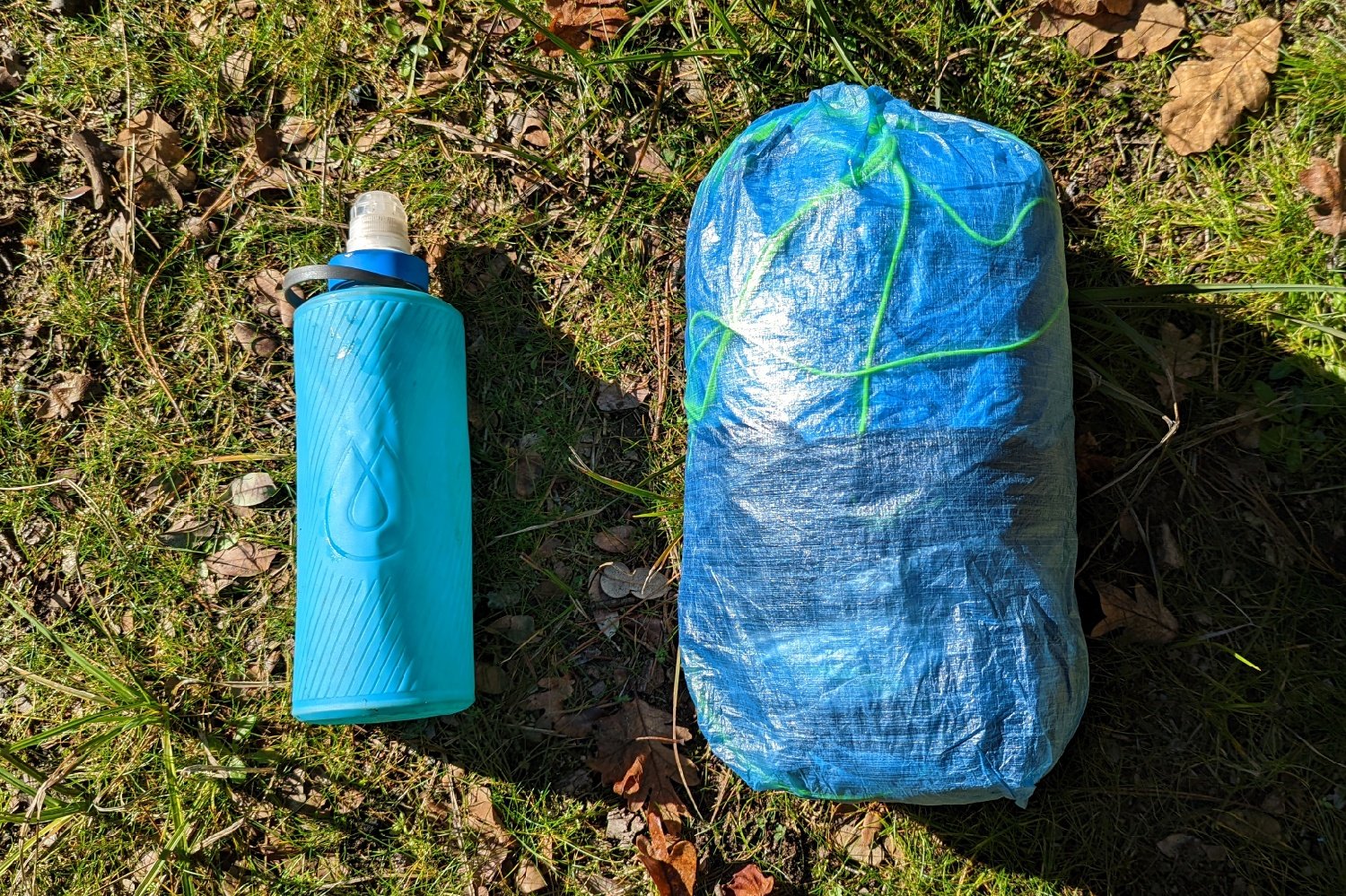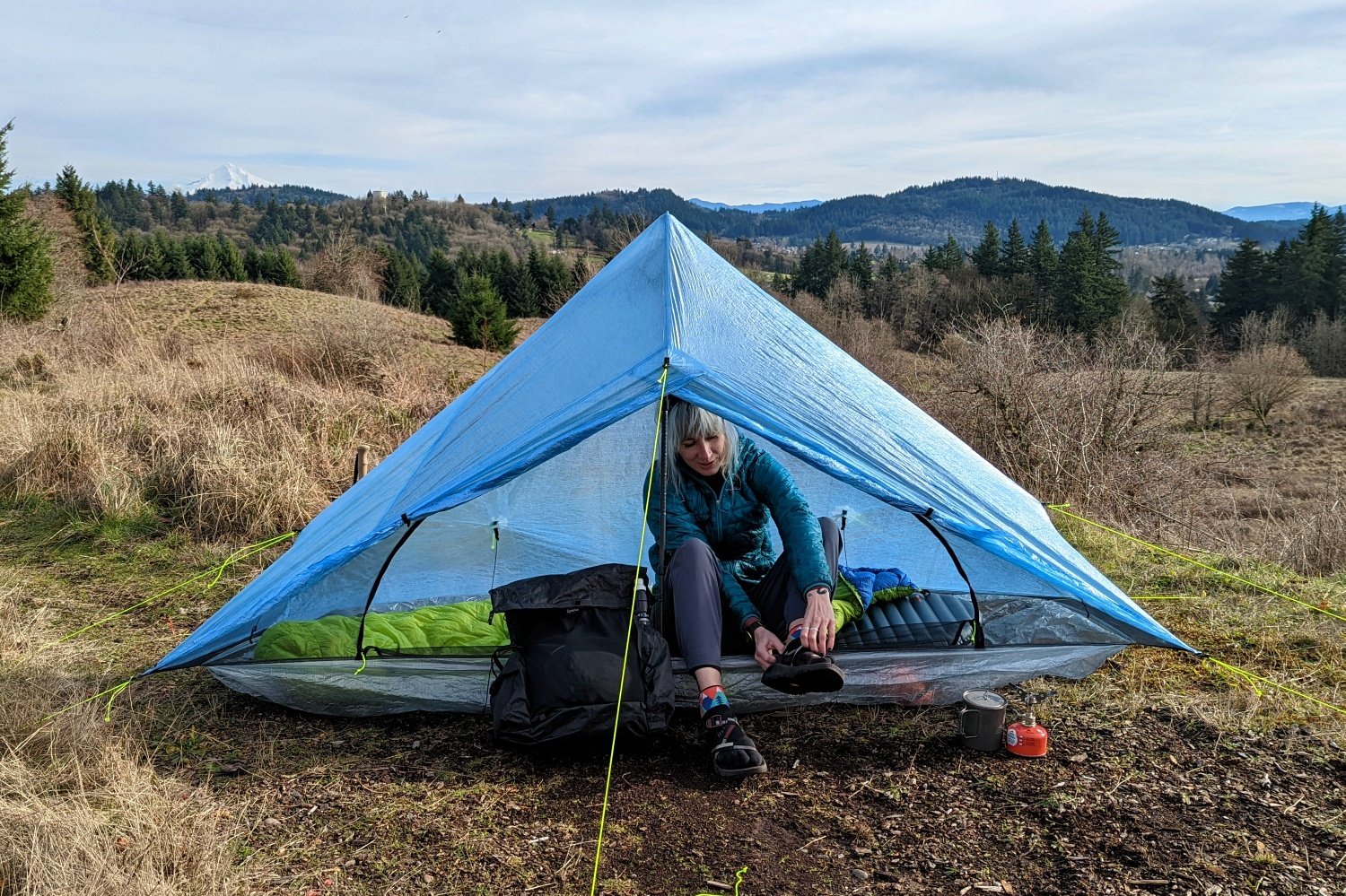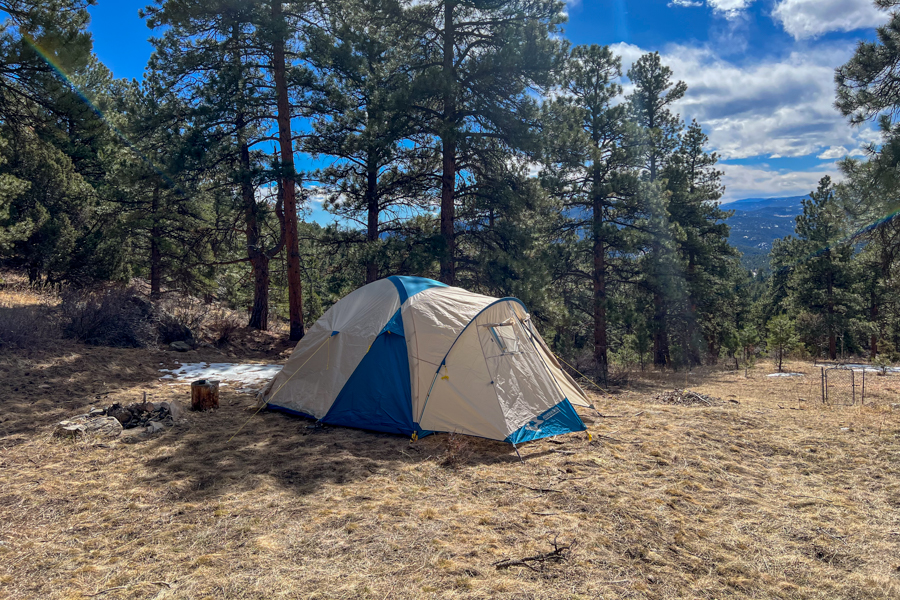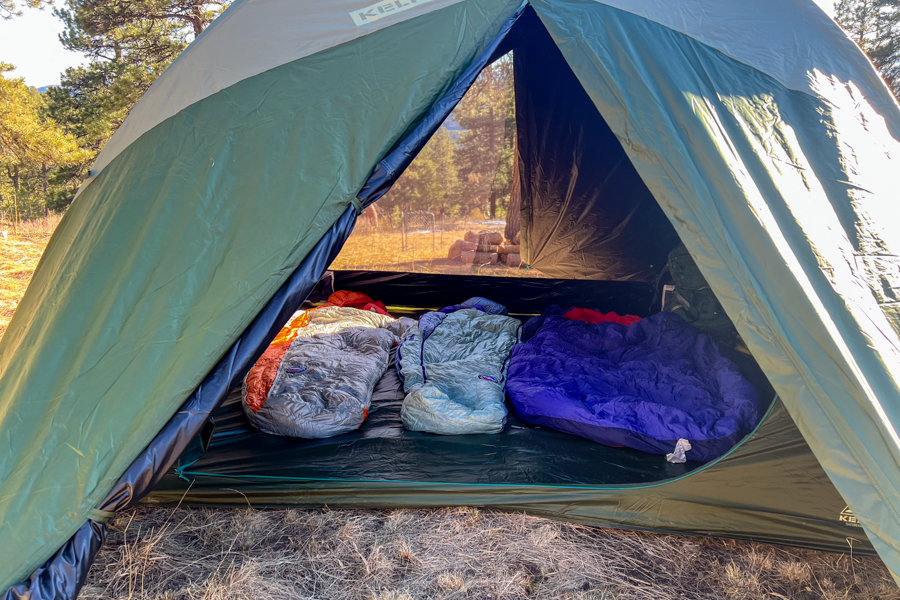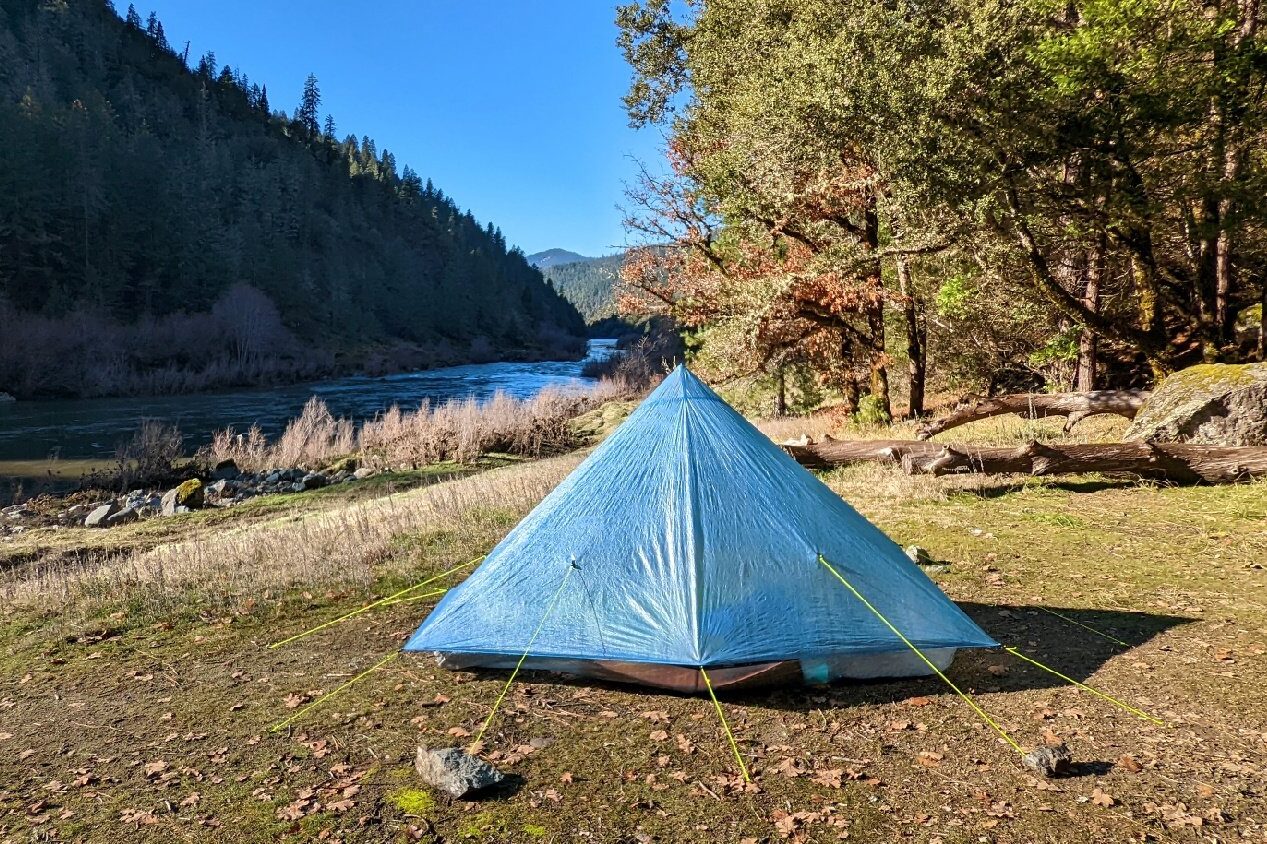
Bottom Line
The Zpacks Plex Solo is one of the lightest, roomiest, and most compressible shelters out there for solo hikers. It’s also very highly regarded on our lists of the Best Backpacking Tents and Best Ultralight Tents. The Plex Solo was CleverHiker gear analyst Casey Handley’s go-to tent when taking on Vermont’s nearly 250-mile Long Trail and many other long-distance trails. Its simple and efficient pyramid shape offers impressive headroom and excellent weather protection, and the clever ventilation design effectively reduces condensation buildup. This shelter is easy to set up once you get the hang of it. It also packs down exceptionally small – making it perfect for single backpackers, thru-hikers, and minimalists taking on big adventures and huge mileage.
The Plex Solo does have a few drawbacks. It’s one of the pricier one-person shelters out there – although it’s worth every penny for such a low weight and outstanding livability if you put it to good use. This model also doesn’t work well with smaller trekking pole sizes, so you’ll need a pole tall enough to pitch the tent – 52 inches / 132 cm – to its peak height. Finally, non-freestanding shelters aren’t for everyone since they can have condensation issues and aren’t as easy to pitch as freestanding and semi-freestanding options.
Quick Specs
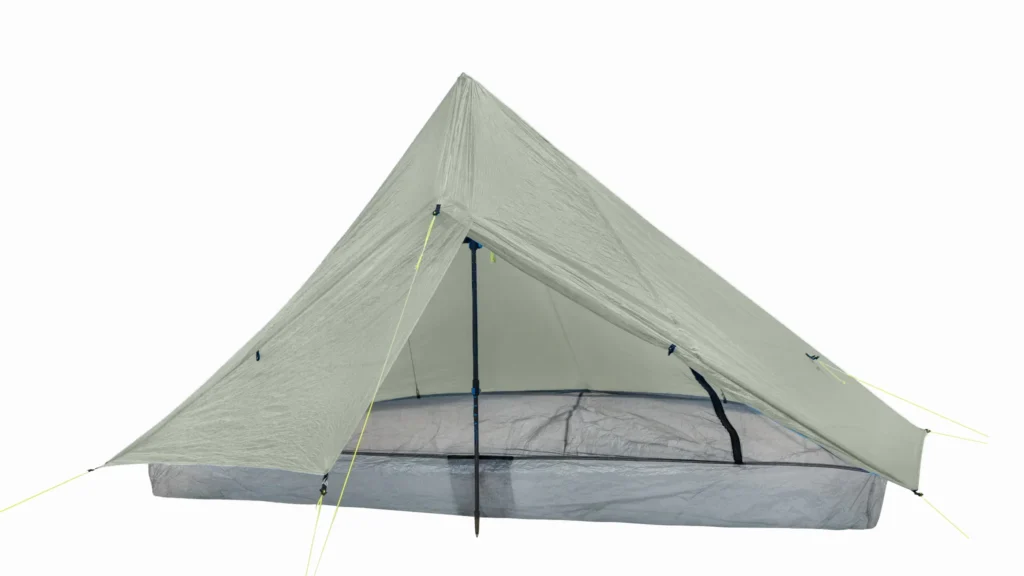
Zpacks Plex Solo Classic
One of the lightest and most livable one-person tents we’ve tested
Price: $599
Measured Weight: 14.2 oz.
Dimensions (LxWxH): 90 x 28/38 (wider in center) x 52 in.
Pros
- Ultralight
- Spacious
- Small Packed Size
- Easy to Set Up
- Sheds Rain Well
- Good Ventilation
- Large Door
Cons
- Expensive
- Trekking poles may be too short to achieve max height
- Non-freestanding
- Single walled tents have condensation issues
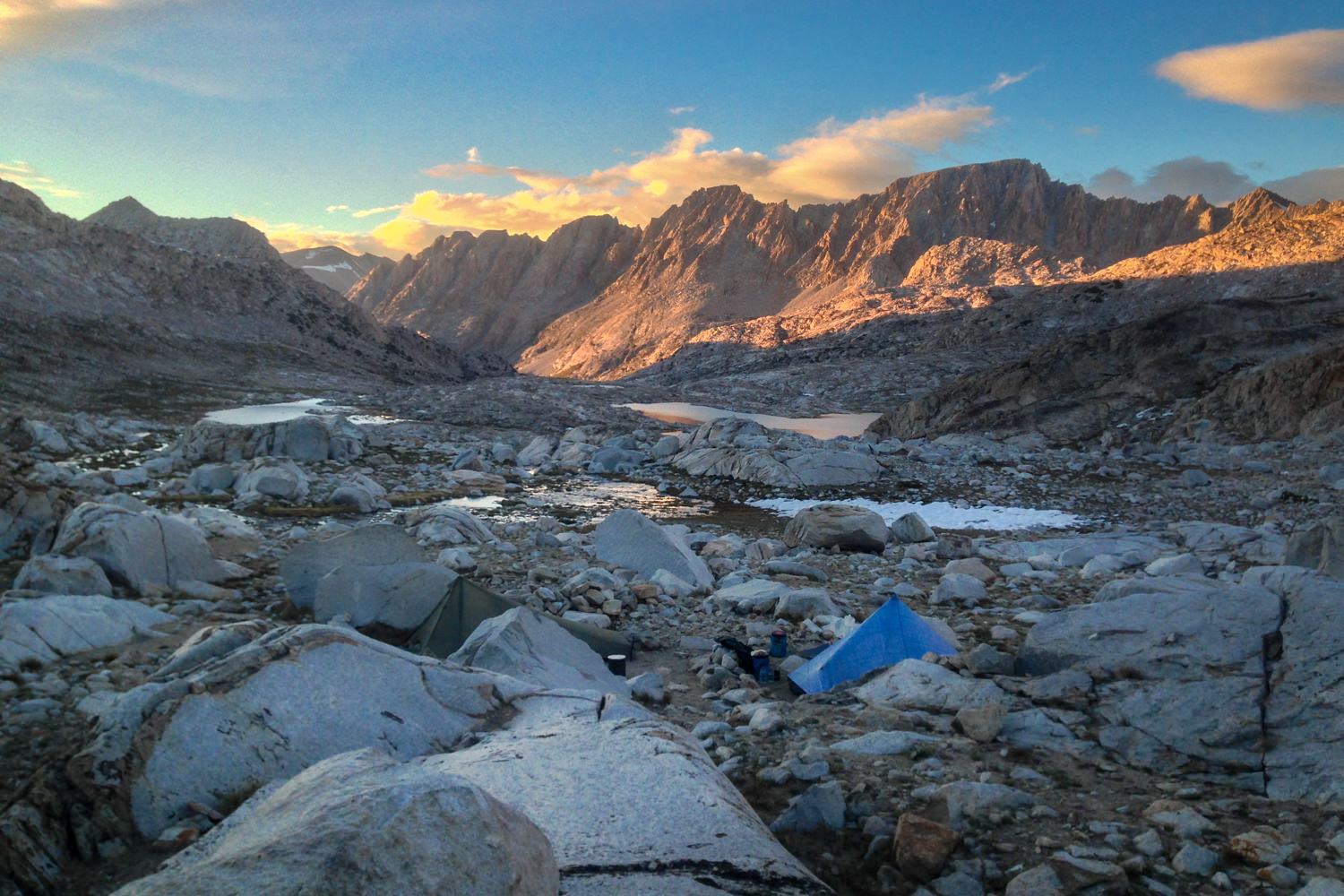
Comfort
The Zpacks Plex Solo is a simple tent with essential features that make it great for solo hikers. The pyramid shape creates a generous interior height of 52 inches, so it’s easy to move around inside and sit up – even for hikers up to six feet tall – and you can always add more headroom by propping up guylines with trekking pole cups (or check out the Alta Plex if you’re up to 6’6” tall). Well-placed guylines expand the Plex Solo’s interior volume to maximize all available space, so there’s plenty of room for gear you don’t want to leave in the vestibule. While single-door designs like the Plex Solo aren’t everyone’s preference, this design works well for one person, and the giant rainbow door makes getting in and out easy. Zpacks also included one small pocket – about 8 by 6 inches – for storing small essentials like a cell phone or headlamp. And while single-wall tents are notorious for condensation, the Solo’s ventilation system generally keeps moisture at bay for a reliably cozy night.
On the downside, the Plex Solo’s simplicity may compromise comfort for hikers who enjoy more features. The small single pocket will underwhelm folks who want more storage for an organized interior. Folks who don’t like small spaces may find issue with the sloped walls of the Plex Solo (the fabric is closer to your face everywhere except in the middle). Because the vestibule, floor space, and pockets are all designed with ultralight backpacking in mind, it requires an organized gear and a sleep system. This might not be a comfortable option if you like exploding your pack and hanging out inside your tent. This shelter works best when you strategically choose which gear to keep outside or inside. For example, a pair of muddy shoes and a wet backpack makes the vestibule a bit tight. Also, the single-door design works well, but its design means the mesh lays directly on the tent’s floor, which could potentially lead to damage – although we’ve never had any problems with this.
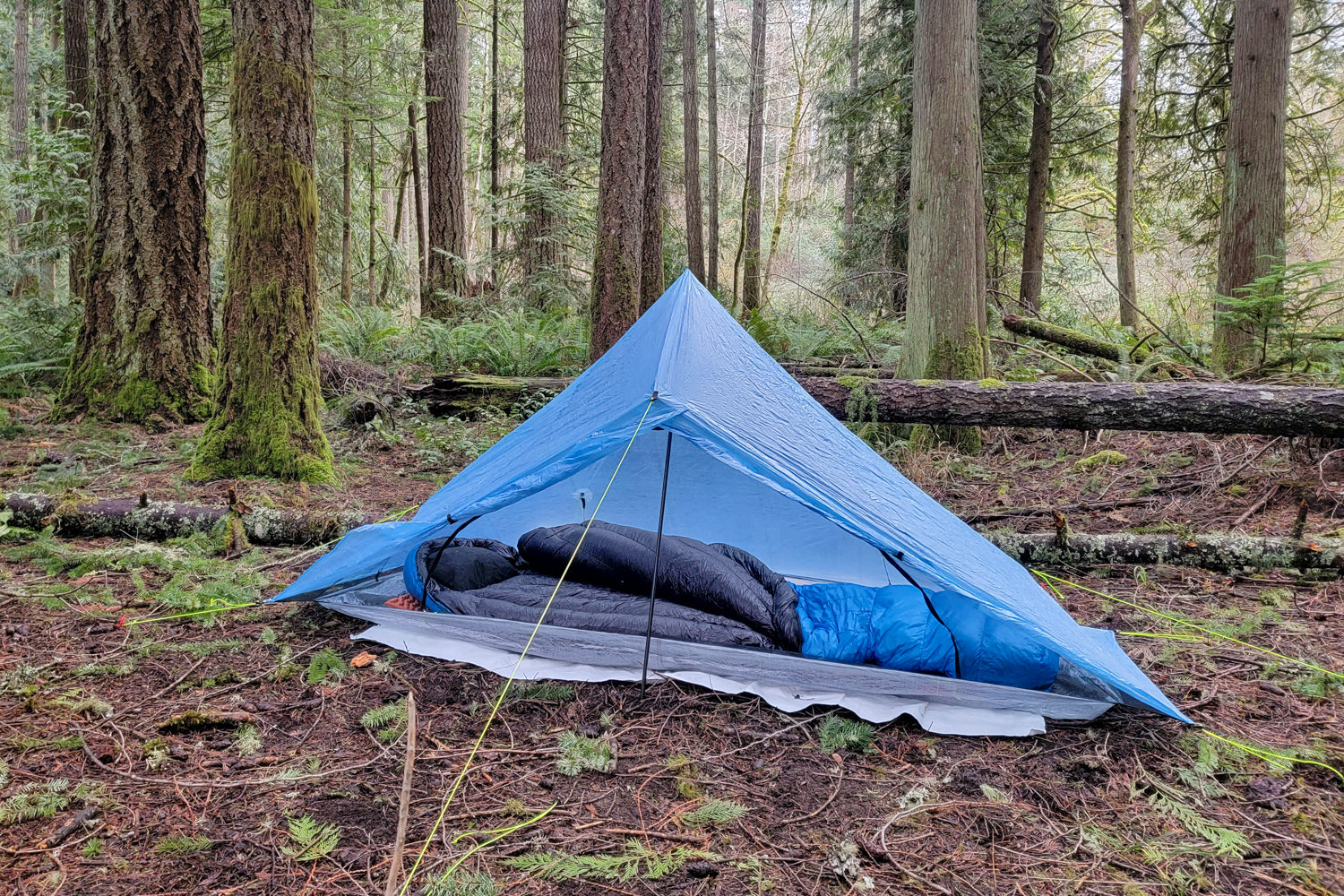
Weight & Packability
This tent is among the lightest and most packable in the world, making it one of our top picks for solo ultralight backpackers. Thanks to ultralight DCF material, the Plex Solo weighs a mere 14.2 ounces (less than a pound!), which dramatically reduces the burden on your back so you can hike farther and longer with less fatigue. It also packs down very small, about the size of a Nalgene water bottle, to free up crucial space in your backpack for other essentials. Its pyramid shape is fairly easy to pack away, but this design still offers tons of headroom and interior volume once pitched. When every ounce matters, this tent’s efficient packed size and low weight translate into easier, faster hiking.
Still, you’ll make a few trade-offs for the Plex Solo’s ultralight design. Its weight doesn’t include the 6 to 10 stakes, nor the additional trekking pole or tent pole required to pitch the tent – both are sold separately – so the real-world weight of the tent will be over a pound with these elements factored in. The other con: DCF doesn’t pack down quite as efficiently as silpoly or silnylon. We have no qualms about the Plex Solo’s tiny 6 by 12-inch packed size, but this is still a bit bulky for an ultralight one-person shelter – although this is a small gripe. All things considered, this tent is one of the easiest shelters on the market to carry for thousands of miles.
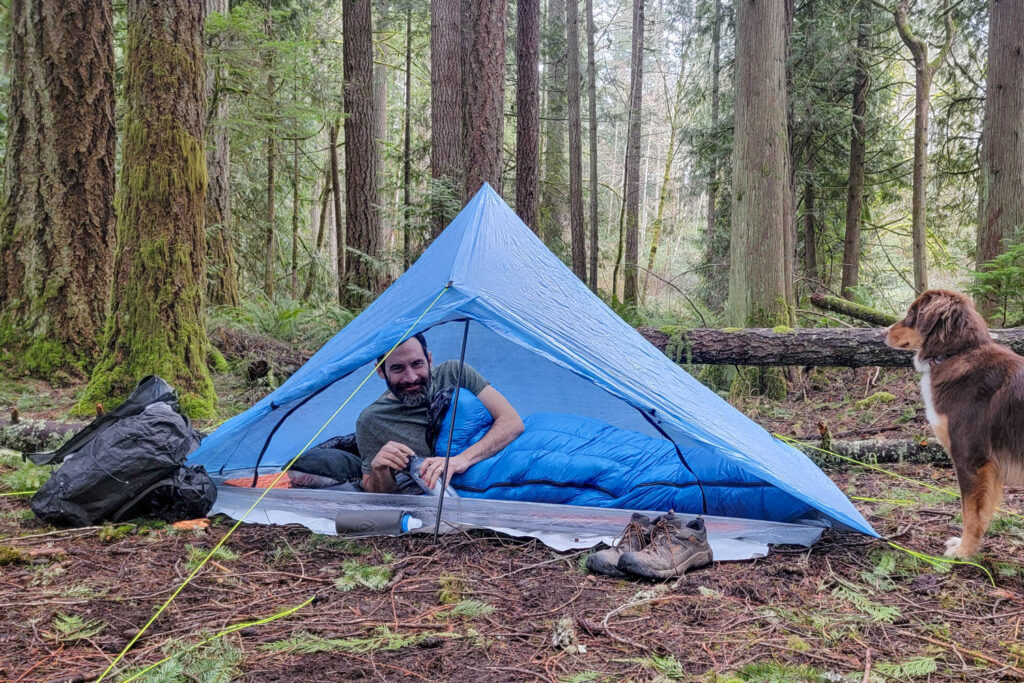
Weather Resistance
The Solo Plex’s pyramid design makes it reliably weather-resistant. Since the sloped walls channel precipitation down and away from the tent, there are no flat areas for water to pool on the surface. It also performs well in windy conditions up to 50 miles per hour, but you’ll need a secure pitch to maximize stability, reduce flapping, and enhance durability. The Solo Plex’s DCF fabric is the key: not only is this fabric tear-resistant, ultralight, and durable, but it doesn’t sag in cold and wet conditions like silnylon and silpoly. DCF tends to dry very quickly as well. Double-stitching and taped seams only make the Plex Solo more storm-worthy, and an 8-inch tall elevated bathtub floor prevents splashback from rain hitting the ground outside.
One of the standout features of the Plex Solo is its smart ventilation design. Mesh around the perimeter of the bathtub floor sits parallel to the ground, so you’ll get plenty of airflow while condensation runs down and exits the tent through these vents instead of dripping on you and your gear. Plus, the rainfly doors are adjustable depending on conditions: leave both sides open when skies are clear, lower one side to block wind, or close both to keep rain out. Unique metal hooks keep the rainfly reliably closed when storms move through.
But no tent is perfect. The Solo Plex’s non-freestanding design depends heavily on proper staking and a taut pitch to keep the rain out. This can sometimes be tricky on rocky ground and in high winds. You’ll also need to pick a fairly flat and open site, since it can be more difficult to set up on uneven terrain. Since the performance of the tent depends on its peak height, it’s crucial your trekking or tent poles are tall enough – they must extend to 52 inches (132 cm) for maximum peak height – which might cost you a bit more if you have shorter poles. And, by virtue of its single-wall construction, condensation is inevitable in humid or cold environments. This model’s ventilation system is outstanding, but it’s likely you’ll still deal with a damp tent interior during long, wet nights, so take care not to rub against the interior of the rainfly.
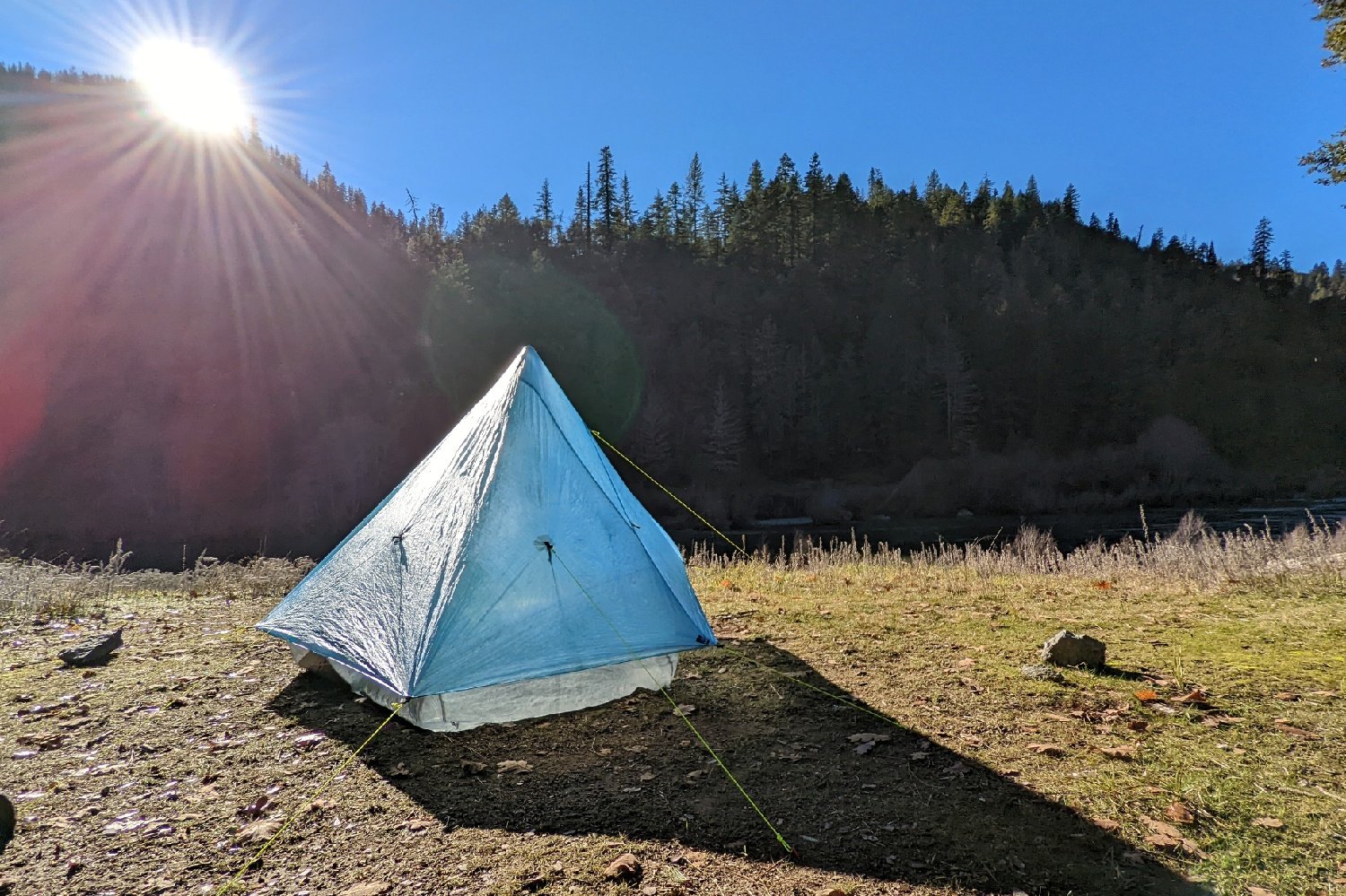
Ease of Setup
If you’ve never used a non-freestanding tent before, the Plex Solo can take some getting used to. Your first time setting it up will be the most challenging, and it might take some trial and error to get the hang of staking the tent out properly. Luckily, the body stakes of the Plex Solo are fixed in a rectangle, so it’s a bit easier and faster to set up than many other pyramid-shaped tents since you won’t need to worry much about tweaking angles. Its pyramid shape uses the center pole to tension the tent and create a simple, taut structure that doesn’t need complex adjustments. As long as the four main stakes are squared off, the setup steps are intuitive and fast – a major advantage in unpredictable weather or windy conditions.
However, if you’re used to the speed and efficiency of a freestanding or semi-freestanding tent, a non-freestanding shelter like the Plex Solo might miss the mark. Setup usually takes more time and focus because tensioning is crucial, so beginners may need a few practice pitches before achieving the ideal pitch. That said, we’re confident you’ll be a pro after a few practice runs, and eventually, setup will take only a few minutes. Also, you’ll need a center pole that can extend to 52 inches long for the best stability and interior space. If the max height of your trekking pole comes up short, consider picking up a dedicated Zpacks tent pole to achieve the recommended peak height. And choose your campsite carefully, prioritizing clear sites with soft to moderate dirt, as rocky or hard ground can make setup more tricky.

Durability
The Zpacks Plex Solo is built with Dyneema Composite Fabric, which is remarkably durable and puncture-resistant, so it’s ideal for unforgiving terrain. The thicker DCF used in this model offers solid protection against abrasions, punctures, and tears, which is crucial when camping on rough or uneven ground. Dyneema’s resistance to stretching under stress means this tent maintains its shape even in heavy winds, and the pyramid design distributes stress evenly across the fabric to reduce wear over time. Plus, the tent comes with pre-taped seams, so you won’t have to pay extra or deal with the hassle of seam sealing, and the tent can easily withstand rain without compromising strength. Even after hundreds of nights in the elements, the Plex Solo’s materials and components will hold up well with minimal maintenance – although if something does happen, field repairs are easy thanks to included DCF repair patches.
However, this Zpacks model does have limitations, especially with the floor material. While it holds up well under most conditions, a protective groundsheet is worth considering if you’re heading into really rough environments. And while DCF is tough, it does require a bit of extra care: we recommend folding and rolling your tent, since stuffing can cause it to break down faster and lead to early wear. And while it offers excellent UV resistance, direct sunlight will contribute to weakened fabric over time. Also, there’s no way around it: DCF is a very expensive material, which is why the Plex Solo is more spendy than other tents of a similar size. Even still, we highly recommend this tent for its reliability over years of use and thousands of miles of backpacking.

Should You Buy the Zpacks Plex Solo?
The Zpacks Plex Solo is an excellent choice for ultralight backpackers who want to save weight without sacrificing durability or weather resistance. Weighing less than a pound, this tent is one of the best on the market for livable, long-lasting, and no-frills ultralight tents. Its DCF construction works well in tough backcountry conditions and provides solid protection from rain, wind, and light snow. The pyramid design sheds precipitation efficiently and holds up well in high winds, and the simple feature set offers only what you need and nothing you don’t. With careful use, the Plex Solo will keep your pack weight down, your tent interior dry, and will last for thousands of miles.
The Plex Solo isn’t the best option for hikers who want an easy setup, lots of features, tend to explode their packs in the tent, and don’t want to deal with condensation management. Its non-freestanding design requires precise staking, which can be tricky in rocky terrain and may require creativity, like stacking rocks on top of tent stakes to keep them secure. This tent’s small single pocket and simple features aren’t for everyone either. The Plex Solo only has one door and vestibule, which we find to be less desirable and convenient than some ultralight solo shelter options with two doors. And still, even considering that list of potential downsides, the Plex Solo is undoubtedly one of the best single-person ultralight backpacking tents available today

What Other Backpacking Tents Should You Consider?
Zpacks Duplex Review: The Zpacks Duplex is like a two-person version of the Solo Plex. It offers the same ultralight and quality construction, but with more room for two hikers, two doors, and vestibules. It’s a bit more expensive and heavier than the Plex Solo, but it’s a better fit if you hike with a partner, and it’s still very light and convenient when used as a solo shelter.
Zpacks Duplex Lite: The Duplex Lite, like the regular Duplex, offers the same simple setup and dual-door design that’s popular among thru-hikers. However, it’s shorter, narrower, and lighter – and more affordable – making it better as a solo shelter or for hikers under 6 feet.
Six Moon Designs Lunar Solo Review: The Six Moon Designs Lunar Solo offers a similar non-freestanding pyramid design and is similar to pitch. However, its biggest attraction is that it costs less than half the price of the Plex Solo. That said, it also weighs significantly more than the Plex and doesn’t have the same weather protection benefits as DCF.
Big Agnes Tiger Wall UL 2 Review: If you like the ultralight nature of the Plex Solo, but you want more convenience and ease of use, the Tiger Wall is an excellent option. It’s a bit heavier (though tent stakes and poles are calculated in its weight), but it’s much faster to set up, has excellent pockets, will give you the option to leave the rainfly off on clear nights, and you won’t have to worry about condensation management. It costs a bit less and is very roomy for single-person use.
Durston X-Mid 2: The Durston X-Mid 2 is another solid non-freestanding tent, but since it’s a two-person shelter, it offers two doors and much more width and headroom. It’s also a much more affordable option, though it’s more than twice as heavy as the Plex Solo and a bit more complex to pitch.



